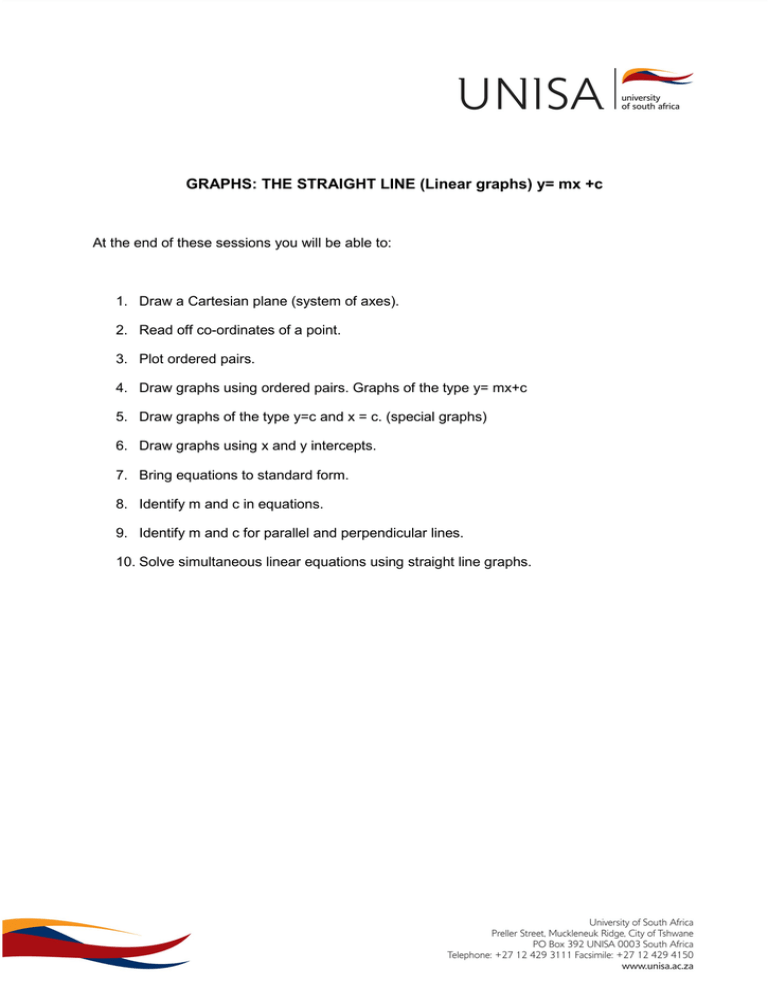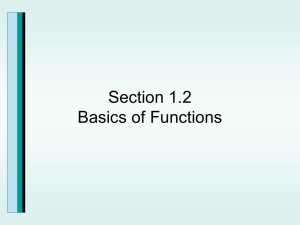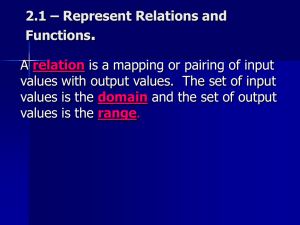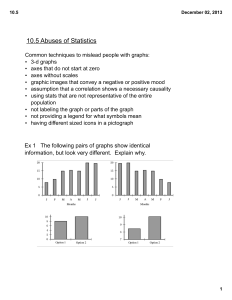GRAPHS: THE STRAIGHT LINE (Linear graphs) y= mx +c
advertisement

GRAPHS: THE STRAIGHT LINE (Linear graphs) y= mx +c At the end of these sessions you will be able to: 1. Draw a Cartesian plane (system of axes). 2. Read off co-ordinates of a point. 3. Plot ordered pairs. 4. Draw graphs using ordered pairs. Graphs of the type y= mx+c 5. Draw graphs of the type y=c and x = c. (special graphs) 6. Draw graphs using x and y intercepts. 7. Bring equations to standard form. 8. Identify m and c in equations. 9. Identify m and c for parallel and perpendicular lines. 10. Solve simultaneous linear equations using straight line graphs. The basics of drawing linear graphs Activity One: Draw a system of axes and label the axes. On each axis show -5 to 5. State two other names you can use instead of a system of axes. Label the quadrants. Introduction In order to draw graphs you have to know substitution and you also need to understand the Cartesian. The Cartesian plane is also called the XOY plane. The Cartesian plane is made up of the X axis and the Y axis. DRAW XOY PLANE - also known as Cartesian plane or System of axes. Quadrants are always labeled in anti-clockwise order. Application Draw a system of axes on a square line page. Show numbers as above and label the quadrants. We say one axis and many axes. The X and Y axes divides the Cartesian plane into 4 quarters. Each quarter is called a quadrant. Each quadrant is made of an infinite number of points. Infinite means there is so many that you can never count them all. Each point can be described in a special way called an ordered pair. Each point is labeled using a capital letter. Activity 2 Draw a system of axes and plot the following points. A(3;2) B(-2;4) C(-1;-4) D(2;-3) E(0;3) F(-3; 0) G(0;-4) H(4;0) DRAW XOY PLANE SHOWING POINTS For example A is the point (3; 2) and is written in a short way as A (3; 2). The first number is called the x co-ordinate and the second number is the y co-ordinate. (3 ; 2) is called an ordered pair because the x will always be first and the y will always be after the x. X will always be first and y will always be second. Sometimes the first number is called the ordinate and the second number is called the abscissa. The popular way is to call the first number the x co-ordinate and the second number is the y co-ordinate. Similarly B is the point B (- 2; 4) Similarly C is the point C (- 1; - 4) Similarly D is the point D (2; - 3) Similarly E is the point E (0; 3) Similarly F is the point F (- 3; 0) Similarly G is the point G (0; - 4) Similarly H is the point H (4; 0) Activity 3: Application: EX 1. Find the co-ordinates (ordered pairs) for points I to R on the above system of axes. I(2;4) J(-4;2) K(-3;-2) L(4;2) M(2;0) N(-1;0) P(0;1) R(0;-2) Plotting points The next step is to learn to plot points. Whenever you plot points, you must first find the x value and then plot the y value. Remember a positive y means you move up and a negative y means you move down. For example to plot A (2; 3), you first locate 2 on the x axis and then move 3 units up. Draw a system of axes and plot the following points. Just place a dot at the right point and use capital letters to label the point. To plot B (- 2; 1), you first locate - 2 on the x axis and then move 1 unit up. To plot C (- 2; - 3), you first locate - 2 on the x axis and then move 3 units down. To plot D (2; - 3), you first locate 2 on the x axis and then move 3 units down. To plot E (3; 0), you first locate 3 on the x axis and then place a dot on 3. To plot F (- 4; 0), you first locate - 4 on the x axis and then place a dot on - 4. To plot G (0; -3), you first locate 0 on the x axis and then move down to - 3. To plot H (0; 4), you first locate 0 on the x axis and then move down to 4. Activity 4: APPLICATION: EX 2 Plot the following points. I (4 ; 2) J (- 2 ; 3) P (0; -1) K (-3 ; -1) Q (0; 2) L (4 ; - 2) M (1 ; 0) N (-2 ; 0) O(0;0) Example one: Sketch the graph of y= 2x. In order to draw the graph you have to first find ordered pairs, that means you choose any 3 numbers and substitute in y =2x. Let’s choose x = 0; x = 1 and x = 2. By substitution: y =2x y=2x y=2x y=2(0) y=2(1) y=2(2) y=0 y= 2 The ordered pairs are (0;0) (1;2) y= 4 (2;4) Sometimes the above is represented in a table of values as follows x 0 1 2 y 0 2 4 Because you can choose any x values, x is called the independent variable and y is called the dependent variable because y depends on the value of x. We plot the points (0; 0); (1; 2); (2; 4) and use a ruler and draw a straight line and label the line. Example two: Sketch the graph of y = 2x - 1 Build ordered pairs. Suppose we choose x = -1 or x = 0 or x=1 y = 2x - 1 y = 2x - 1 y = 2x - 1 y=2(-1) - 1 y =2(0) - 1 y=2(1) - 1 = -2-1 =0-1 = -3 (-1; -3) =2 - 1 = -1 (0; -1) =1 (1; 1) Activity 5: Application: EX 3.1 Sketch y = -2x and y = -2x + 1 on the same system of axes. The ordered pairs for y = -2x are (-1; 2) (0; 0) (1; -2) The ordered pairs for y = -2x + 1 are (-1; 3) (0; 1) (1; -1) Example Three: Sketch y = 3 and x = 4. These are called special graphs. For y= 3 the ordered pairs will be (0;3) (1;3) (3;3) etc. In all ordered pairs y=3 is satisfied or you can substitute in y = 0x + 3 and check for yourself. For x = 4 the ordered pairs will be (4;0) (4;1) (4;2) etc. In all ordered pairs x = 4 is satisfied. Activity 6: Application: Ex 4. 1. 2. 3. 4. 5. 6. 7. 8. y =3x y=x+1 y=x - 1 y= ½ x + 2 y= -2x + 1 y= - x + 1 y= -2x - 2 Draw y = 2x + 1 and y = - ½ x - 2 on the same system of axes and check if the lines are parallel or perpendicular i.e. forming a right angle when they intersect. 9. Draw y = 2x + 1 and y = 2x - 2 on the same system of axes and check if the lines are parallel or perpendicular i.e. forming a right angle when they intersect. Feedback for activity 6, numbers 1 to 7 EQUATION ORDERED PAIRS 1. y =3x (-1; -3) (0; 0) (1; 3) 2. y = x + 1 (-1; 0) (0; 1) (1; 2) 3. y = x - 1 (-1; -2) (0; -1) (1; 0) 4. y= ½ x + 2 (-1; 1,5) (0; 2) (1; 2,5) 5. y= -2x + 1 (-1;3 ) (0; 1) (1;-1 ) 6. y= - x + 1 (-1; 0 ) (0;1 ) (1; 0) 7. y= -2x - 2 (-1; 0) (0; -2 ) (1; -4 ) Sketching graphs using x and y intercepts Consider the graph of y = ½ x - 2. The y intercept is - 2 and the x intercept are 4. Example: Sketch 3x + 2y = - 6 For x intercept, put y=0 3x + 2y = - 6 3x + 2 (0) = - 6 3x = - 6 x= - 2 Plot (- 2; 0) For y intercept, put x = 0 3x + 2y = - 6 3(0) + 2y = - 6 2y = - 6 y= - 3 Plot (0; -3) See above for sketch. Activity 7: APPLICATION: Ex 5 Draw the following graphs using x and y intercepts. 1. 2. 3. 4. 5. y= 2x + 4 y= 2x - 2 2x + 3y = 6 x - 2y = 4 ½x+½y=2 Feedback for activity 7 No. Equation X intercept Y intercept 1 y= 2x + 4 x = -2 y= 4 2 y= 2x - 2 x=1 y= -2 3 2x + 3y = 6 x=3 y= 2 4 x - 2y = 4 x=4 y= -2 5 ½ x + ½y = 2 x=4 y= 4 The standard form of a straight line y = mx + c An equation is in standard form if it is written as y = …… in another words y must be the subject of the formula e.g. y = 3x - 1 is in standard form while - y = 2x - 1 and 3x + 4y = 12 etc. are not in standard form. An equation is brought to standard form by using laws of equations. Activity 8: Bring 6x - 2y = 12 into standard form. Example: Bring 6x - 2y = 12 into standard form. 6x - 2y = 12 - 2y = -6x + 12 y= -6x/-2 + 12/-2 y = 3x - 6 Note well that any equation of a graph is in standard form only when the co-efficient (number) in front of y is positive 1 and the index of y is 1. Once an equation is in standard form the coefficient of x represents the gradient. The abbreviation for gradient is m and the number (the constant) represents the y intercept of the graph and the abbreviation for y intercept is c. E.g. in y = 3x - 6 the gradient is 3 or m = 3 and the y intercept is - 6 or c = - 6 3x E.g. in y = 4 - 3; m = ¾ and c = - 3. Activity 9: 9 1. State the relationship between the gradients of two lines to be parallel and for two lines to be perpendicular. 2. Draw the graphs of y= -2x and y = -2x + 3 on the same system of axes. Check if the graphs are parallel or perpendicular (cutting at right angles). 3. Draw the graphs of y= -2x and y = ½ x + 1 on the same system of axes. Check if the graphs are parallel or perpendicular (cutting at right angles). PARALLEL LINES: Draw the graphs of y= -2x and y = -2x + 3 on the same system of axes. Check if the graphs are parallel or perpendicular (cutting at right angles). You will notice that the graphs are parallel. Remember that parallel lines have equal gradients. PERPENDICULAR LINES Draw the graphs of y= -2x and y = ½ x + 1 on the same system of axes. Check if the graphs are parallel or perpendicular (cutting at right angles). You will notice that the graphs are perpendicular. Remember that the product of the gradients of perpendicular lines is -1 i.e. m1 x m2 = -1. Activity 10. Application: EX 6. Bring to standard form. 3x + 4y = 12 2x - 5y = 10 x-y=7 3x - 2y = 5 3x - 4y = - 7 Feedback for activity 10 3x + 4y = 12 4y = -3x + 12 y = -3/4x + 3 ir y = 0,75x + 3 2x - 5y = 10 -5y = -2x + 10 y= 2/5x - 2 ir y = 0,4x - 2 x-y=7 -y = -x + 7 y=x-7 3x - 2y = 5 -2y = -3x + 5 y = 3/2x - 5/3 or y = 1,5x - 1,67 3x - 4y = - 7 - 4 y = -3x - 7 y = 3/4x + 7/4 or y = 0,75x + 1,75 Activity 11 Exercise 7 COMPLETE THE FOLOWING TABLE No. Given equation Standard form Gradient of given line m Slope of given line Gradient of line parallel to given line. m c 1 y - 3x + 2= 0 2 3y - 12 x = + 5 3 y + 5x - 7 = 0 4 2 y + 3x = 6 5 5x - 4y = 20 Gradient of line perpendicular to given line. m Feedback No. Given equation Standard form Gradient of given line m Slope of given line Gradient of line parallel to given line. m c Gradient of line perpendicular to given line. m 1 y - 3x + 2= 0 y= 3x - 2 3 -2 3 -1/3 2 3y - 12 x = + 5 y= 4x + 5/3 4 5/3 4 -1/4 3 y + 5x - 7 = 0 y= -5x + 7 -5 7 -5 1/5 4 2 y + 3x = 6 y = -3/2x + 3 -3/2 3 -3/2 -1/3 5 5x - 4y = 20 y= 5/4 x - 5 5/4 -5 5/4 -4/5 Finding equations of straight lines: y = mx + c (3 Steps) Activity 12 Determine the equation of a straight line passing through the points (2; 7) and (5; 16). In order to determine the equation we have to determine the gradient (m) and the y intercept(c) and then substitute m and c into y = mx + c. STEP ONE: CALCULATE GRADIENT (The symbol for gradient is “m”) Calculate the gradient using m= [y2 -y1] ÷ [x2 - x1]. It is important to label the ordered pairs as (x1; y1) and (x2; y2). Any one of the two ordered pairs can be (x1; y1) and the other pair can be (x2; y2). Let (2; 7) be (x1; y1) and let (5; 16) be (x2; y2). y 2 − y1 m = x 2 − x1 N.B. another word for gradient is slope or tangent. 16 − 7 = 5−2 =9÷3 =3 STEP 2: CALCULATE Y INTERCEPT c Put m and any one ordered pair into y = mx + c and solve for c. Use any one ordered pair through which the line passes. y = mx + c 7 = 3(2) + c 7=6+c 7-6=c 1=c m= 3 (see above) Lets use (2; 7). Now x = 2 and y = 7. STEP 3: SUBSTITUTE m and c into y= mx + c y = mx + c m=3 and c=1 (see above two steps) y = 3x + 1 Activity 13 APPLICATION: Ex 8 Find the equation of the line passing through the following pairs of points. 1. (2; 5) and (4; 9) 2. (5; 9) and (6; 11) 3. (6; 1) and (10; 3) Feedback: Solutions for Activity 13, Ex 8 1. (2; 5) and (4; 9) m= 9-5/ [4-2] = 4/2 =2 y=mx + c 9= 2(4) + c 9=8 + c 1= c y = 2x + 1 2. (5; 9) and (6; 11) m =11-9/ [6-5] = 2/1 =2 y=mx + c 11= 2(6) + c 11=12 + c -1= c y = 2x - 1 3. (6; 1) and (10; 3) m = [3-1]/ [10-6] = 2/4 =½ y=mx + c 1= ½ (6) + c 1= 3 + c -2= c y= ½x-2 References Bradley, T 2008, Essential Mathematics for Economics and business, 3rd edition, West Sussex England, John Wiley and Sons. Unisa Learner Guide-Introductory Financial Mathematics, DSC1630, 2010, Pretoria, University of South Africa. Unisa Learner Guide-Elementary Quantitative Methods, QMI1500, 2010, Pretoria, University of South Africa. Unisa Learner Guide-Quantitative Modelling 1, DSC1520, 2010, Pretoria, University of South Africa. Unisa Learner Guide-Introduction to Economic and Management EnvironmentB, INM 102-4, 2007, Pretoria, University of South Africa. Developed by: D.Kooblal (Roshan), Quantitative Literacy Facilitator, Unisa (Durban), June 2013



